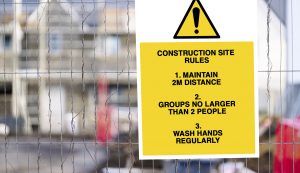Collaborative construction in the ‘new normal’

Collaboration is at the heart of the construction and infrastructure industries. Yet in the time of the coronavirus, its very significance has unfortunately been threatened. With many of us now considering how we can return to work under these ‘new normal’ conditions, what will the effects be on collaboration? How can the industries collaborate in times of social distancing? This blog gives insight into how the construction and infrastructure sectors can collaborate during and post-pandemic, looking at the challenges that might emerge as a result of complying with social distancing enforcement.
Collaborating in the ‘new normal’ will be no easy feat, especially where safety is concerned. Safety is one of the things the industry is continually driving towards, but since the coronavirus its very importance has become even more more essential.
As with many businesses across the world, HAKI is a global organisation. Collaboration is ingrained into our working culture; we travel in order to connect with each other and be productive. Whilst applications such as Microsoft Teams and Zoom are bridging this sudden disconnection, human interaction is still needed. So much can be said through body language – a handshake, for instance – yet this is unfortunately impossible at the moment. We are instead, and naturally, turning to substitutes.
Human interaction forms the very basis of work onsite and is key to collaborative working, in a physical sense. Although many employees can work collectively on a project through computer applications, the two-metre social distancing enforcement will prove to make it difficult for workers onsite, particularly those working with more traditional methods of scaffolding. The most basic method of scaffolding, the most common component, is a 5ft tube. How can two workers maintain a safe two-metre distance when passing fittings to each other?
What about system scaffold?
System scaffold, which is prefabricated, will definitely come into its own as a potential solution that can ensure projects go ahead whilst complying with social distancing measures. Unlike traditional methods, system scaffolding uses far less components and requires no mechanical fixings. The benefit here is twofold. Firstly, it reduces manual operation and lengthy hammer action at height, and secondly it lowers the number of workers required to complete the job at hand. To put it simply, system scaffolding needs fewer workers in less time.
The NASC has published guidance on how to work on socially-distanced construction sites. It pinpoints that where it is not possible to socially distance, workers should face away from each other, minimise the frequency they are together and reduce the number of employees involved in any given task. By lowering the number of staff and the time taken to fit scaffold, risk is significantly reduced. Two workers can collaborate and keep their time working together to a minimum.
Furthermore, temporary access solutions including stair towers can manage the amount of foot traffic entering and exiting a space, and can facilitate the flow of one-way traffic – a prerequisite to maintaining social distancing in the time of coronavirus. With the use of stair towers therefore, it is far easier to keep the two-metre distance and control who can be onsite at a given time. Temporary crossings, using solutions such as the HAKI Bridge System, are a further option which can be utilised to control foot traffic and mediate the flow of people on a site, or in public spaces integrated with the Public Access Stair.
BIM and collaboration
Prior to the pandemic, digital was certainly helping the industry collaborate across projects. Yet, since the coronavirus there has been a notable increase in the number of workers using technology on a daily basis. BIM (Building Information Modelling) is giving a project’s entire supply chain improved visibility when it comes to planning, designing and managing built assets. The intelligent 3D model is optimising work processes and collaboration, which is essential in a time where many of us cannot work together physically. Although technology within the scaffold sector is still in its infancy its prospects are invaluable, with 4D BIM in particular more focussed on collaborative working.
Whilst it is still too soon to really be able to paint a full picture of what collaboration will look like in the ‘new normal’, small steps can be taken to ensure workers execute their duties safely and at a two-metre distance. The construction and infrastructure industries have to continually mitigate against risk and the coronavirus is just another hazard which has to be controlled. Although it is difficult to say whether we will return to collaborative working as we know it, the idea of us being able to make positive changes is a comfort. As humans we are able to acclimatise ourselves to new things. Adapting to the ‘new normal’ and a different way to collaborate, will eventually be something we are unable to see as abnormal.
Contact us to learn more about how we can help during COVID-19 and beyond
 Haki has now acquired vertemax – Discover the
Haki has now acquired vertemax – Discover the 